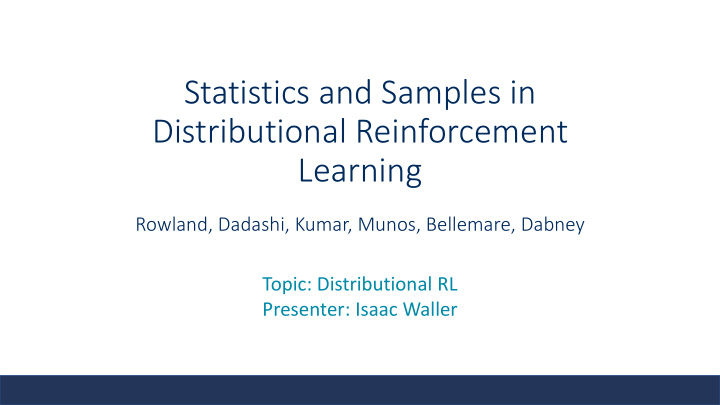



Statistics and Samples in Distributional Reinforcement Learning Rowland, Dadashi, Kumar, Munos, Bellemare, Dabney Topic: Distributional RL Presenter: Isaac Waller
Distributional RL Instead of approximating the return with a value function, learn the distribution of the return = 𝜃(𝑦, 𝑏) . ➢ A better model for multi-modal return distributions Image https://reinforcement-learning-kr.github.io/2018/09/27/Distributional_intro/
Categorical Distributional RL (CDRL) Assumes a categorical form for return distributions 𝜃(𝑦, 𝑏) Fixed set of supports 𝑨 1 … 𝑨 𝐿 Learn probability 𝑞 𝑙 (𝑦, 𝑏) for each 𝑙 Image https://joshgreaves.com/reinforcement-learning/understanding-rl-the-bellman-equations/
Quantile Distributional RL (QDRL) Learn 𝐿 quantiles of the return distributions 𝜃 𝑦, 𝑏 Each learnable parameter 𝑨 𝑙 has equal probability mass Image https://joshgreaves.com/reinforcement-learning/understanding-rl-the-bellman-equations/
Motivation Lack of a unifying framework for these distributional RL algorithms A general approach will - Assess how well these algorithms model return distributions - Inform the development of new distributional RL algorithms
Contributions - Demonstrates that distributional RL algorithms can be decomposed into some statistics and an imputation mechanism - Shows that CDRL and QDRL inherently cannot learn exactly the true statistics of the return distribution - Develops a new algorithm – EDRL – which can exactly learn the true expectiles of the return distribution - Empirically demonstrates that EDRL is competitive and sometimes an improvement on past algorithms
Bellman equations Bellman equation Distributional Bellman equation?
CDRL and QDRL Bellman updates CDRL QDRL Update 𝑞 𝑙 (𝑦, 𝑏) to the probability Update quantiles 𝑨 𝑙 to the mass for 𝑨 𝑙 when 𝑎 𝜌 (𝑦, 𝑏) is observed quantiles of 𝑎 𝜌 (𝑦, 𝑏) . projected onto only 𝑨 1 … 𝑨 𝑙 . (See Appendix A.2) (See Appendix A.3)
Any algorithm = Statistics + imputation strategies CDRL QDRL Statistics: 𝒕 𝟐 … 𝒕 𝑳 Statistics: 𝒕 𝟐 … 𝒕 𝑳 𝐿 probability masses of return 𝐿 quantiles of return distribution distribution projected onto supports 𝑨 1 … 𝑨 𝑙 Imputation strategy 𝛀 : Imputation strategy 𝛀 : 𝑳 𝒕 𝟐…𝑳 = 𝟐 𝑳 𝛀 ො 𝑳 𝜺 ො 𝒕 𝒍 𝛀 ො ො 𝒕 𝟐…𝑳 = 𝒕 𝒍 𝜺 𝒜 𝒍 Bellman update:
Any algorithm = Statistics + imputation strategies
Bellman closedness Bellman closedness: a set of statistics is Bellman closed if, for each 𝑦, 𝑏 ∈ 𝑌 × 𝐵 , the statistics 𝑡 1…𝐿 𝜃 𝜌 𝑦, 𝑏 can be expressed purely in terms of the random variables 𝑆 0 and 𝑡 1…𝐿 𝜃 𝜌 𝑌 1 , 𝐵 1 |𝑌 0 = 𝑦, 𝐵 0 = 𝑏 and the discount factor 𝛿 . Theorem 4.3 : Collections of moments are “effectively” the only finite sets of statistics that are Bellman closed. Proof in Appendix B.2
Bellman closedness The sets of statistics used by CDRL and QDRL are not Bellman closed Those algorithms are not capable of exactly learning their statistics (* but in practice seem to be effective anyways…) Does not imply that they are incapable of correctly learning expected returns, only distribution
New algorithm: EDRL Using expectiles Can be exactly learned using Bellman updates
New algorithm: EDRL Imputation strategy: Find a distribution satisfying (7) Or (equivalently) that minimizes (8)
Learnt return distributions
Experimental Results Distance to goal Above: estimation error EDRL best approximates statistics
Experimental Results EDRL does best job at estimating true mean
Experimental Results Figure 8. Mean and median human normalised scores across all 57 Atari games. Number of statistics learnt for each algorithm indicated in parentheses.
Discussion of results • EDRL matches or exceeds performance of the other distributional RL algorithms • Using imputation strategies grounded in the theoretical framework can improve accuracy of learned statistics • Conclusion: the theoretical framework is sound and useful. Should be incorporated into future study in distributional RL.
Critique / Limitations / Open Issues • EDRL does not give enormous improvements in performance over other DRL algorithms and is significantly more complex. • Is it truly important to learn the exact return distribution? Learning an inexact distribution appears to perform fine with regards to policy performance, which is what matters in the end. • Or: perhaps test scenarios are not complex enough to allow distributional RL to showcase true power
Contributions (Recap) - Demonstrates that distributional RL algorithms can be decomposed into some statistics and an imputation mechanism - Shows that CDRL and QDRL inherently cannot learn exactly the true statistics of the return distribution - Develops a new algorithm – EDRL – which can exactly learn the true expectiles of the return distribution - Empirically demonstrates that EDRL is competitive and sometimes an improvement on past algorithms
Practice questions 1. Prove the set of statistics learned under QDRL is not Bellman closed. (Hint: prove by counterexample) 2. Give an example of a set of statistics which is Bellman closed that is not expectiles or the mean.
Recommend
More recommend